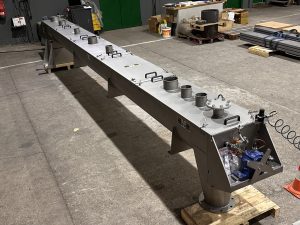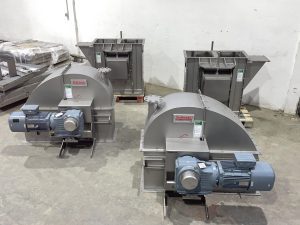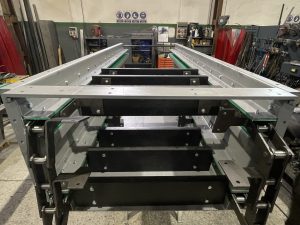Bulk Solids Conveyor Design
An efficient conveyor system for handling bulk solids requires one crucial step before selecting the type of conveyor. The most critical—and often most underestimated—step is the thorough analysis of the material to be conveyed. Deep knowledge of the product’s characteristics ensures not only a technically accurate solution but also greater durability, lower maintenance costs, and optimized industrial productivity.
The key lies in understanding the material to be conveyed
Each bulk material has unique physical properties that directly impact conveyor performance. A generic or modular design for a screw conveyor, bucket elevator, or chain conveyor may lead to operational failures, blockages, premature wear, or even unexpected production line shutdowns. The design must begin with a data-driven approach based on the product these conveyors will handle. Below are the key properties to study and the methodology:
Technical characterization of the material
- Bulk density
- Particle size distribution and shape
- Flowability, cohesion, and angle of repose
- Moisture content and fines
- Temperature
- Abrasiveness
Laboratory tests and pilot plant trials
- Particle size analysis
- Flow testing
- Angle of repose
- Abrasiveness and hardness
- Moisture and cohesion
- Full-scale pilot testing
Operation of the sinfimasa test rig
Screw conveyor design based on material behavior
The screw conveyor is a versatile and compact solution for horizontal or slightly inclined transport of dry products. However, its design must be carefully tailored to the product’s properties.
Key variables in screw design
- Type of helix
- Diameter, speed, power
- Construction materials and coatings
When to choose custom screw conveyors
Certain materials pose specific handling challenges due to their cohesive, wet, or abrasive nature. In these cases, a standard screw conveyor may not suffice, and a custom design is required to ensure consistent flow, operational efficiency, and equipment longevity.
For instance, when the product tends to stick or compact, an effective solution is the use of shaftless screws. This design removes the central shaft, allowing the material to flow freely through the trough, avoiding the compaction effect common in standard screws where material builds up around the shaft.
Another strategy to reduce stickiness is applying elastomeric linings inside the screw and casing. These linings not only minimize material adhesion but also provide added protection against erosion, abrasion, corrosion, and cavitation, significantly extending equipment life.
Moreover, the choice of construction material is a critical factor in custom screw design. Depending on the product’s characteristics, the following may be required:
- Carbon steels for standard applications
- Stainless or super stainless steels for corrosive or hygienic applications
- Wear-resistant steels or technical coatings for abrasive or high-temperature materials
Finally, an optimal design must also consider appropriate sizing, screw speed, and the capacity needed to meet production efficiently, while minimizing maintenance and ensuring a long operational life.

Custom screw conveyor
Bucket elevator design for bulk solids
Bucket elevators are ideal for vertical transport of dry, abrasive, or fragile materials. They offer the most efficient solution when a height change is needed in a compact space.
Critical design aspects
- Bucket type
- Speed and drive system
- Discharge geometry
Design considerations based on product properties
When designing a bucket elevator, all components must be tailored to the specific characteristics of the material to be lifted. Fragile, abrasive, greasy, or high-temperature products require careful selection of materials and configurations to ensure reliable, long-lasting performance.
As with screw conveyors, product behavior dictates the overall system design. Buckets can be made of different materials depending on the application:
- Carbon steel or stainless steel for heavy-duty or demanding conditions
- HDPE (high-density polyethylene), nylon, or polyurethane for fragile products or when wear resistance is needed without damaging the product
The conveyor belt must also be selected based on product requirements:
- Abrasion-resistant belts for aggressive materials
- Oil- or grease-resistant belts for products containing these compounds
- Heat-resistant belts, or chain elevators instead of belts for high-temperature products
- Food-grade belts when compliance with sanitary regulations is required
The elevator structure’s construction material can vary based on the working environment and product type:
- Carbon steel for general industrial applications
- AISI 304 or 316 stainless steel for corrosive or food-grade products
- Internal wear zones lined with technical plastics or anti-abrasion steel plates in critical contact areas
This level of customization ensures the bucket elevator perfectly suits the product type and offers long life with minimal maintenance, even under demanding operating conditions.

Custom bucket elevator
Chain conveyor (redler) design for complex materials
Redler conveyors are ideal for demanding industrial environments involving highly abrasive, corrosive, explosive materials, or where sealing is critical.
Essential design elements
- Chain type
- Enclosed geometry
- Guides and self-cleaning systems
- Vibration damping
When a custom redler is the optimal solution
Chain conveyors, or redlers, are particularly suitable for sealed, robust, and safe conveying—especially for abrasive, corrosive materials or those with low bulk density. Their enclosed design and chain drive allow for precise material flow control, minimizing leaks, contamination, or dust emissions.
This type of conveyor is ideal for industries such as:
- Abrasive minerals, requiring a strong casing, reinforced chains, and internal wear-resistant linings
- Corrosive fertilizers, needing stainless steel, treated chains, and sealing components for harsh environments
- Alternative fuels (RDF) or highly volatile materials with extremely low bulk densities, where the redler ensures compact, controlled conveying with minimal dispersion, product loss, or safety risks
In all cases, the chain conveyor design must be precisely adapted to material characteristics. This includes:
- Chain type (reinforced links, fins, special coatings)
- Sliders or wear guides made of high-performance technical materials
- Wear zones with specific linings to extend service life
- Precise geometric sizing and speed adjustment to ensure efficient, quiet, and low-maintenance transport

Custom chain conveyor
Advantages of data-driven design
Designing a conveying system adapted to each material type allows for:
- Preventing blockages and operational failures
- Extending equipment lifespan
- Reducing maintenance
- Improving energy efficiency
- Meeting specific regulations
Conclusion: To optimize efficiency in bulk solids handling processes and minimize maintenance costs, it is essential to provide personalized engineering services—starting with material analysis, flow testing on a pilot rig, and designing custom equipment to ensure reliable, durable, and safe conveyors.





